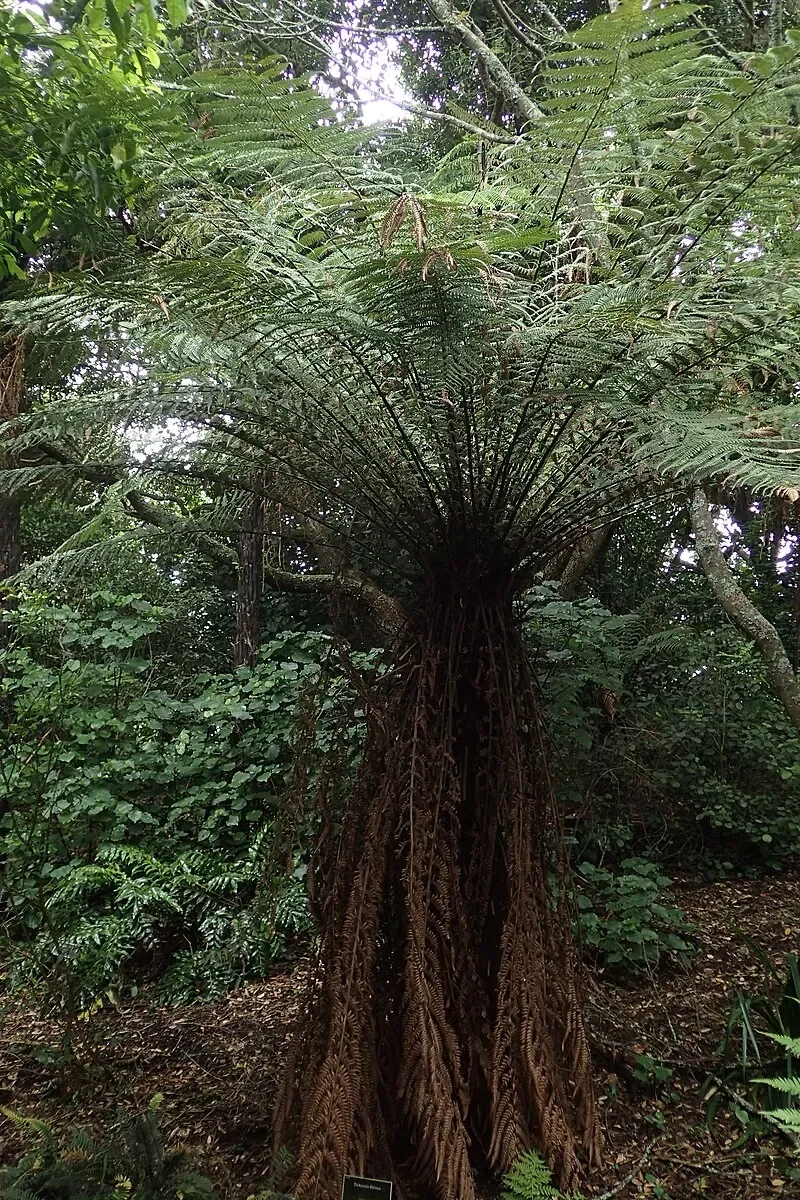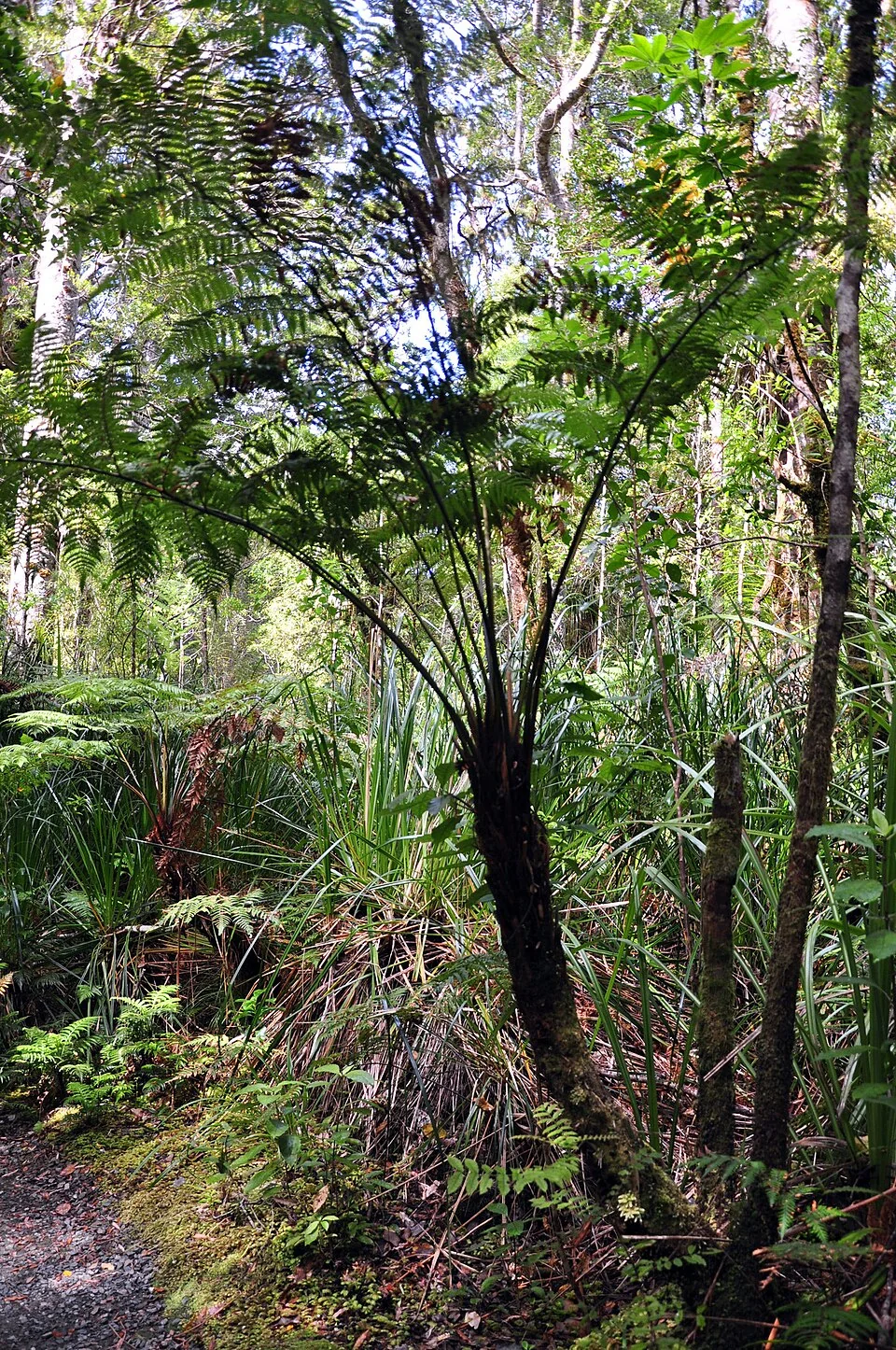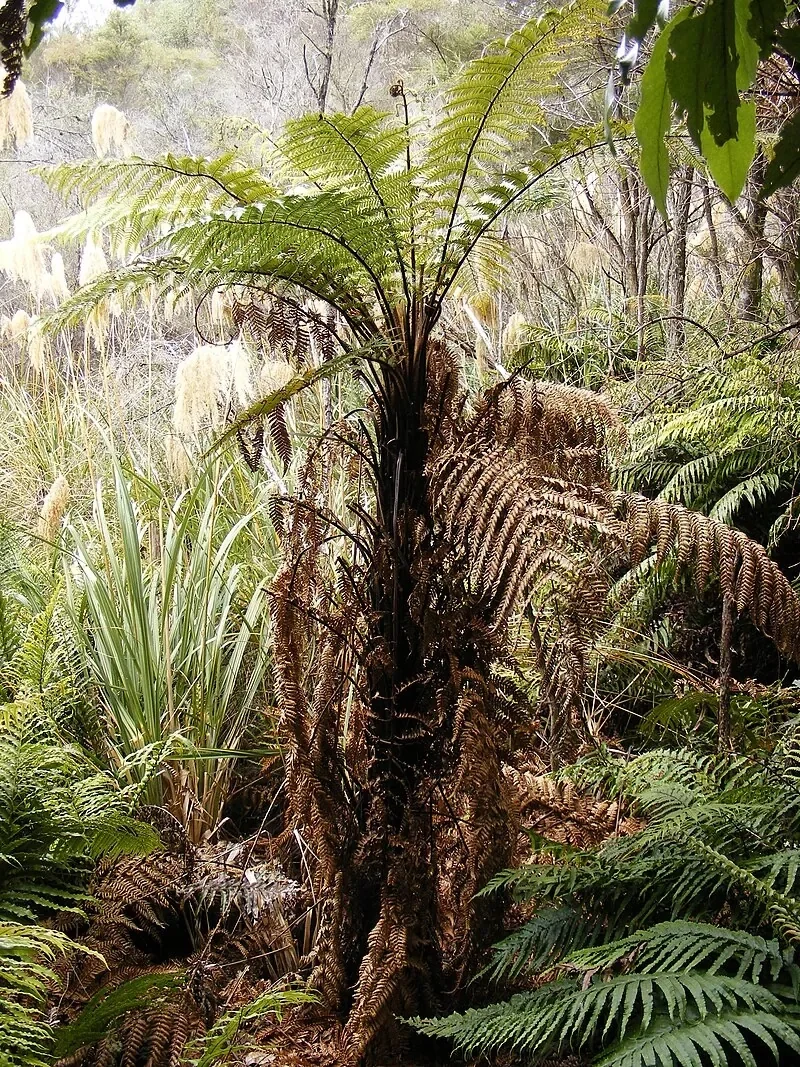
Whēkī-ponga
Dicksonia fibrosa
Whēkā-ponga ( Dicksonia fibrosa ) represents one of New Zealand's most architecturally striking and culturally significant tree ferns , creating dramatic landscape features with its distinctive fibrous trunk and crown of massive fronds that can span up to 3.6 meters in length. Known also as golden tree fern or jade tree fern, this magnificent plant develops one of the most recognizable silhouettes in New Zealand's native forests, with its characteristic "skirt" of hanging dead fronds that creates a natural protective barrier around the thick, fibrous trunk. This remarkable adaptation not only helps insulate the growing crown from temperature extremes but also creates crucial habitat for numerous epiphytes, small ferns, and invertebrates that make their homes within the protective frond skirt. The trunk itself represents a marvel of botanical engineering - composed of densely interwoven reddish-brown rootlets that can reach up to one meter in diameter, creating a structure so robust that it was traditionally harvested by Māori for construction purposes, particularly for creating the structural posts of buildings where its rot-resistant properties proved invaluable. Growing slowly but steadily to heights of 6-10 meters over many decades, Whēkā-ponga demonstrates the patience required to create truly impressive garden specimens, with mature plants becoming living sculptures that can dominate a landscape for generations. The fern's glossy, dark green fronds emerge in a perfect crown formation, creating an umbrella-like canopy that filters light beautifully while providing shelter for understory plants below. Found naturally in the cool, moist gullies and wet areas of New Zealand's coastal and montane forests, this species has evolved remarkable cold tolerance for a tree fern, capable of withstanding sub-zero temperatures that would kill many of its relatives. Beyond its striking appearance, Whēkā-ponga plays crucial ecological roles in forest ecosystems, with its slowly decomposing trunk providing a long-term source of organic matter and its fronds creating vital nesting sites for native birds, while the plant's ability to thrive in low-light conditions makes it an excellent choice for creating dramatic focal points in shaded garden areas.

Plant Description
Botanical Features
Dicksonia fibrosa , also known as Whēkā-ponga or Golden Tree Fern, is a medium-sized, slow-growing evergreen tree fern native to New Zealand. It is characterized by its dense, stout, and fibrous rusty-brown trunk, which can reach up to 10 meters tall and 1 meter in diameter, composed of tightly interwoven red-brown rootlets. A distinctive feature is its persistent dead fronds, which form a dense, pendent, tidy skirt beneath the crown of living fronds. The living fronds are numerous, erect, and arching, forming a dense, tight crown that can be 1.2-3.6 meters long. The stipes (frond stalks) are smooth, pale brown to red-brown, and can be up to 300 mm long, with bases densely covered in soft, light red-brown hairs. The fronds themselves are dark green, glossy on the underside, and harshly leathery. This tree fern is adaptable and can be found in various habitats, from coastal to montane areas, preferring wet environments and gulleys under full forest cover. It can tolerate both sun and shade, as well as moderate frost, wind, and drought.
Quick Facts
| Scientific Name | Dicksonia Fibrosa |
|---|---|
| Height | 6-20 m |
| Spread | 4-8 m |
| Water Needs | High |
| Light | Shade to part shade |
| Frost Tolerance | Moderate |
| Salt Tolerance | Poor |
| Growth Rate | Very slow |
| Lifespan | Very long (centuries) |
Climate Best Suited to
Whēkī-ponga ( Dicksonia fibrosa ) thrives in cool, moist, shaded forest conditions with high humidity and protection from wind. It adapts well to typical New Zealand growing conditions with appropriate care and positioning.
Regional Suitability
| City | Climate Suitability |
|---|---|
| Whangārei | Ideal |
| Auckland | Ideal |
| Hamilton | Ideal |
| Tauranga | Ideal |
| Rotorua | Ideal |
| Gisborne | Ideal |
| New Plymouth | Ideal |
| Napier | Ideal |
| Whanganui | Ideal |
| Palmerston North | Ideal |
| Wellington | Ideal |
| Nelson | Ideal |
| Christchurch | Ideal |
| Dunedin | Ideal |
| Invercargill | Ideal |
Natural Habitat
Whēkā-ponga is a common sight in cool, moist forests throughout New Zealand, from coastal areas to lower montane regions. It is particularly abundant in the wetter, western parts of the country. This tree fern thrives in the damp, shaded conditions of the forest understory, often growing in gullies and along stream banks where the soil is consistently moist. While it can tolerate some sun, it is most at home in the dappled light of the forest floor, where it is protected from strong winds and harsh sunlight.
Plant Conservation
The conservation status of Dicksonia fibrosa (also known as golden tree fern, whēkī-ponga, whēkī-kohoonga, or kuripaka) is "Not Threatened" as of 2017, according to the conservation listings. This status has been consistent since at least 2004. It is an endemic species to New Zealand.
Growing Requirements
Soil Requirements
Whēkī-ponga ( Dicksonia fibrosa ) performs best in well-draining soil that retains adequate moisture. Like most New Zealand natives, it prefers soils that don't become waterlogged but maintain consistent moisture levels. Good drainage is essential for healthy root development.
- Well-draining soil essential for healthy growth
- Prefers consistent moisture without waterlogging
- Adapts to various soil types with good drainage
- Benefits from organic matter incorporation
- Mulching helps retain moisture and suppress weeds
Light Requirements
Whēkī-ponga ( Dicksonia fibrosa ) performs well in full sun to partial shade conditions. Like many New Zealand natives, it adapts to various light conditions but typically shows best growth and form in positions that receive adequate sunlight throughout the day.
- Full sun to partial shade positions
- At least 4-6 hours of direct sunlight daily
- Tolerates light shade in warmer climates
- Morning sun particularly beneficial
Water Requirements
Whēkī-ponga ( Dicksonia fibrosa ) requires regular watering during establishment, typically for the first 1-2 years. Once established, it becomes more drought-tolerant but benefits from consistent moisture during dry periods. Avoid overwatering which can lead to root problems.
- Regular watering during establishment phase
- Moderate drought tolerance once established
- Consistent moisture during dry periods beneficial
- Avoid waterlogged conditions
- Mulching helps conserve soil moisture
Planting Guide
Whēkā-ponga is a magnificent tree fern that can bring a touch of the New Zealand forest to your garden. It is a slow-growing but long-lived plant that will eventually become a stunning feature. To ensure your Whēkā-ponga thrives, it is important to provide it with the right conditions from the start.
Site Selection
- Light: This tree fern prefers a shaded or semi-shaded position, protected from the harsh afternoon sun. Dappled light under the canopy of larger trees is ideal.
- Soil: Whēkā-ponga requires a moist, humus-rich, and well-draining soil. It will not tolerate waterlogged conditions, so good drainage is essential.
- Shelter: A sheltered spot is crucial, as strong winds can damage the large fronds.
Planting Instructions
- Timing: Plant in spring or autumn when the soil is moist and temperatures are mild.
- Planting: Dig a hole that is twice the width of the root ball. Gently place the fern in the hole, ensuring it is planted at the same depth as it was in its container. Backfill with soil and water in well.
Ongoing Care
- Watering: Consistent moisture is key. Water the trunk and the base of the plant regularly, especially during dry periods.
- Mulching: Apply a thick layer of mulch around the base of the fern to help retain moisture and keep the roots cool.
- Feeding: A slow-release fertiliser can be applied in spring to encourage healthy growth.
- Pruning: Pruning is generally not required, as the old fronds form a protective skirt around the trunk. You can remove any fronds that are completely dead or damaged.
Ecological Role
Environmental Benefits
The whēkā-ponga or golden tree fern ( Dicksonia fibrosa ) is a structural keystone in moist lowland forest and gullies. Its fibrous trunk and spreading fronds cast deep shade, buffering humidity and temperature on the forest floor. Old frond bases and trunk fibre shelter invertebrates and epiphytes, while persistent leaf litter builds a spongy, humus-rich layer that slows runoff and protects shallow roots.
- Microclimate engineer: Creates cool, humid refuges beneath the canopy for ferns, liverworts, and seedlings.
- Habitat provider: Trunks host perching plants and invertebrates; fallen fronds become nurse material.
- Bank stabiliser: Shallow fibrous roots and accumulated duff bind soil on shaded slopes and stream edges.
Uses and Significance
Garden Uses
- Excellent for native plant gardens and restoration
- Suitable for naturalistic landscape designs
- Low maintenance once established
- Contributes to local biodiversity
- Attractive to beneficial native wildlife
Landscaping Uses
Whēkā-ponga is a highly sought-after ornamental plant in landscaping, prized for its classic, symmetrical shuttlecock-like crown and the distinctive fibrous trunk that gives it a unique architectural quality. Its robust nature and adaptability make it a versatile choice for a variety of garden styles.
Key Landscaping Applications:
- Specimen Plant: With its strong, symmetrical form, Whēkā-ponga makes a stunning focal point in a garden. Its dense crown of fronds creates a dramatic statement, and the skirt of dead fronds adds to its unique character.
- Native and Fern Gardens: It is an essential component of any native New Zealand garden or fernery, where it can be planted in groups to create a lush, forest-like atmosphere.
- Sub-tropical Themes: The classic tree fern shape of Whēkā-ponga is perfect for creating a sub-tropical or jungle-like feel in a garden. It pairs well with other large-leaved plants like hostas and ligularias.
- Container Planting: While it will eventually outgrow a container, young plants can be grown in large pots for several years, making it a suitable choice for patios and courtyards.
When planting Whēkā-ponga, it is important to remember that it is a slow-growing species. However, its longevity and the dramatic statement it makes in the landscape make it a worthwhile investment.
Seasonal Care Calendar
Spring
Spring is an active growth period for Whēkī-ponga ( Dicksonia fibrosa ). New growth emerges and this is an ideal time for planting new specimens. Monitor soil moisture as temperatures warm and growth accelerates.
- Active growth period with new foliage development
- Ideal time for planting new specimens
- Monitor soil moisture as temperatures rise
- Apply organic mulch if needed
Summer
Summer is typically the main growing season for Whēkī-ponga ( Dicksonia fibrosa ). Ensure adequate watering during hot, dry periods, especially for young plants. Established plants show good heat tolerance with appropriate care.
- Peak growing season with active development
- Monitor watering needs during hot weather
- Young plants need consistent moisture
- Established plants show good heat tolerance
Autumn
During autumn, Whēkī-ponga ( Dicksonia fibrosa ) begins to slow its growth as temperatures cool. This is another good time for planting as conditions become more favorable. Reduce watering frequency but maintain soil moisture.
- Growth slows as temperatures moderate
- Good time for planting new specimens
- Reduce watering frequency gradually
- Maintain soil moisture without overwatering
Winter
Winter is typically a dormant period for Whēkī-ponga ( Dicksonia fibrosa ), with minimal growth activity. Reduce watering but ensure plants don't completely dry out. Most New Zealand natives are cold-hardy and require minimal winter protection.
- Dormant period with minimal growth activity
- Reduce watering but avoid complete drying
- Generally cold-hardy in most New Zealand climates
- Minimal winter protection required
When to Prune and How Much
Whēkī-ponga ( Dicksonia fibrosa ) generally requires minimal pruning to maintain its natural form and health. Most maintenance involves removing dead or damaged growth and light shaping if needed.
- Remove dead, damaged, or diseased growth as needed
- Light pruning to maintain shape if desired
- Prune after flowering if applicable
- Avoid heavy pruning which can stress the plant
- Use clean, sharp tools to prevent disease
- Most natives maintain good form without regular pruning
Always use clean, sharp tools when pruning to minimize disease risk. Native plants typically maintain their natural form well and often require less intervention than exotic species.
How to Grow Whēkī-ponga
Whēkī-ponga, also known as the Golden Tree Fern, is a magnificent and architecturally striking native tree fern that can add a dramatic, prehistoric feel to any garden. Its distinctive fibrous trunk and crown of large, spreading fronds make it a popular choice for shaded, moist gardens, particularly in areas that mimic its natural forest habitat. While it is a slow-growing species, establishing a Whēkī-ponga is a rewarding long-term investment, providing both aesthetic beauty and ecological benefits. Understanding its propagation methods is key to successfully growing this iconic species.
From Spores
Propagating Whēkī-ponga from spores is the primary method for reproduction in nature and can be a rewarding endeavor for patient gardeners. Collect mature spores from the undersides of healthy fronds when they are dark brown and easily dislodge. Sow the spores onto a sterile, moist substrate, such as peat or a specialized fern-growing medium, in a sealed container to maintain high humidity. Keep the container in a warm, dimly lit location. Germination can take several weeks to many months, forming a green, moss-like prothallus. Eventually, tiny fern sporophytes will emerge. Once they are large enough to handle, transplant them into individual pots and gradually acclimate them to lower humidity before planting out.
From Trunk Sections
For established Whēkī-ponga, propagation from trunk sections is a surprisingly effective method, particularly for salvaging damaged plants or for creating new specimens from mature trunks. This method involves cutting a section of the trunk (at least 30-50 cm long) from a healthy plant. Ensure the top end is clearly marked. Plant the trunk section upright in a well-draining, humus-rich soil mix, burying about one-third of its length. Keep the trunk consistently moist, especially the top, and provide shade. New fronds will eventually emerge from the top of the trunk. This method is often used for larger specimens and can provide a quicker route to a mature-looking plant than spore propagation.
Pests and Diseases
Generally Tough, Watch the Crown
The whēkā-ponga or golden tree fern ( Dicksonia fibrosa ) is robust when planted in a cool, moist, well-drained site. Most problems arise from prolonged dryness at the crown or waterlogging around the trunk base. Keep new croziers protected from hot, desiccating wind and avoid burying the crown under mulch.
- Crown desiccation: In hot, dry spells the growing tip can dry and stall. Water into the trunk fibre sparingly and mist frond bases in heatwaves.
- Root/collar rot: Poor drainage can rot the basal trunk. Plant slightly high and avoid standing water.
- Scale and mealybugs: Occasionally colonise frond midribs, leading to sooty mould. Wipe or hose off; treat severe cases with horticultural oil.
- Slugs and snails: May nibble emerging croziers in damp gardens; hand-pick or use pet-safe barriers.
- Frond scorch: Cold, dry winds brown pinnae edges. Provide shelter and steady moisture.
- Fungal spots: Old fronds may show cosmetic leaf spots; remove senescent fronds to improve air movement.
Avoid fertilisers high in salts around the crown; if feeding, use a light top-dress of leaf mould or well-rotted compost outside the trunk to maintain a humus-rich root zone.
Cultural Significance
Traditional Uses and Values
Dicksonia fibrosa , commonly known as whēkā-ponga, holds significant cultural importance, particularly within Māori culture in New Zealand. Its fibrous trunk was traditionally utilized for various practical purposes.
- Construction Material: The robust, rot-resistant fibrous trunk of Dicksonia fibrosa was highly valued by Māori for construction. Slabs cut from the thick stem were used as structural posts for buildings and for lining underground storage spaces.
- Food Storage Protection: The dense, fibrous nature of the trunk also made it effective for protecting food stores against rats.
- Ecological and Heritage Value: Beyond its practical uses, Dicksonia fibrosa is an integral part of New Zealand's unique botanical heritage. It contributes to the understanding and appreciation of native ecosystems and is valued in traditional ecological knowledge. Its distinctive and architecturally striking appearance also makes it a recognizable and significant feature of New Zealand's native forests.
Bonus Tip
When establishing trunked specimens, pack moist sphagnum lightly around the upper trunk fibre and mist during warm weather; this keeps the aerial roots active without soaking the crown. In winter, remove the moss layer to reduce rot risk.







